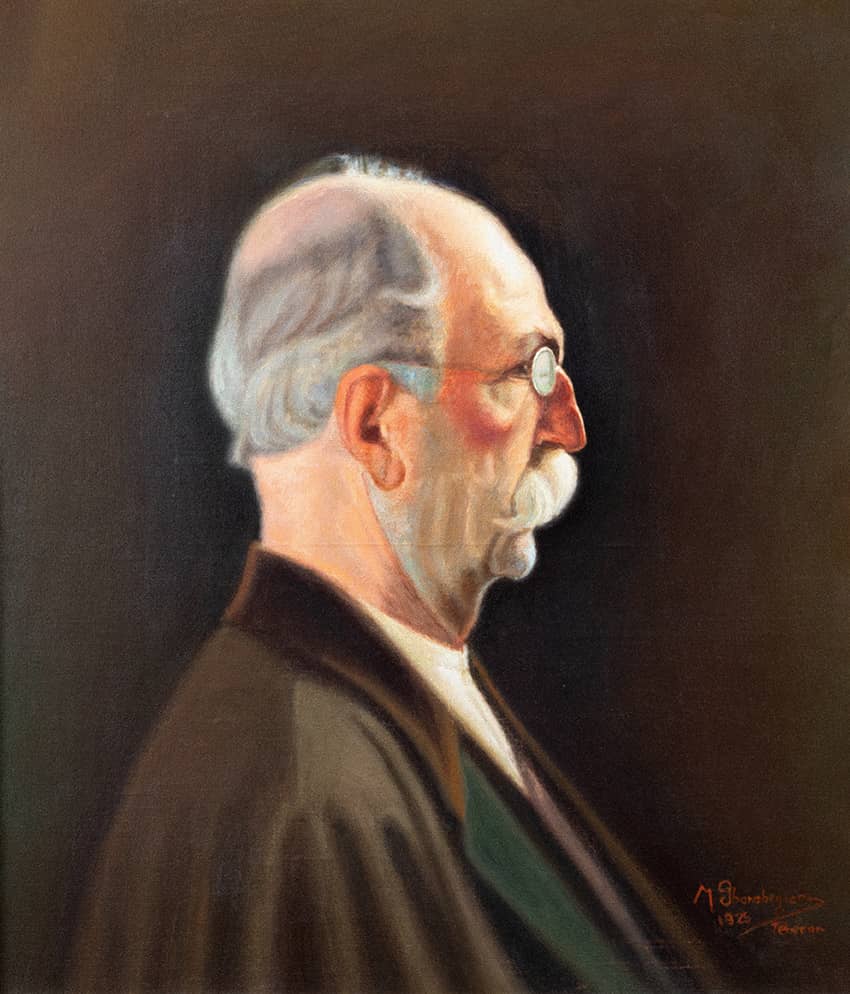
A Century-Old Painting of Kamal-ol-Molk by Markar Gharabegian in Raha Gallery Collection
Dignity in a Frame of Color: The timeless portrait of Kamal-ol-Molk by Markar Gharabegian, painted a hundred years ago, shines within the "Raha Gallery Collection."
ArtDayMe : Raha Gallery Middle East Collection, Founded and directed by engineer Mohammadreza Ghaemmaghami, has been actively committed to cultural engagement in the region for over two decades. The collection preserves a rich array of modern and contemporary masterpieces by both Iranian and Arab artists.
Among these works is an untitled painting by Markar Gharabegian, the skilled Iranian-Armenian painter. Created in 1925 in Tehran using oil on canvas and measuring 50×60 cm, this piece stands out.
The painting is also featured in "Kamal-e Honar" by "Ahmad Sohaili Khansari", a reference book on Kamal-ol-Molk, widely considered the father of modern painting in Iran.
Markar Gharabegian (Tehran, 1901–1976), a painter and poet of Armenian descent, was a direct student of Kamal-ol-Molk.
He adopted two pseudonyms: Demon for his paintings, and Do-DEV for his poetry. Born into a prominent family in Tehran, Gharabegian studied at Kamal-ol-Molk’s art school from 1922 for five years and was one of his most distinguished students. Kamal-ol-Molk admired his work and often showcased Gharabegian’s paintings to visitors at the school.[Qharabegian also trained under a Russian painter named Krazimov.]

Though he followed Kamal-ol-Molk’s classical style, Gharabegian belonged to a group of more moderate disciples who were not deeply attached to strict realism. The presence of impressionistic elements in some of his works supports this view.
In 1946, the Iran–Soviet Cultural Association, with approval from the Ministry of Culture, awarded him the Medal of Art.
In 1973, three years before his death, the Armenian community in Tehran honored him with a ceremony marking fifty years of his artistic career.
His notable students include Sirak Melkonian, Ava Hairabedian, Edik (Edman) Ayvazian, and Clara Abkar.
A Portrait Full of Secrets
This unique and captivating portrait of Kamal-ol-Molk, created a century ago by gharabegian and now held in the Raha Gallery Collection, holds a quiet mystery within.
In one of the most detailed and serene portraits in contemporary Iranian art, the subject is a man who himself shaped the history of Iranian painting: Kamal-ol-Molk. Yet this time, not through his own brush, but through the eyes and hands of Markar Gharabegian — known as Demon — an Armenian artist.
Painted in 1925 (1304 SH), the work bears Qharabegian’s bold signature in the bottom right corner — as pronounced as the commanding presence of the subject himself.
Using precise academic realism, gharabegian gently lifts the master’s face from the folds of time and immortalizes it on canvas.
His brushwork is smooth, continuous, and nearly invisible, creating form and texture not through lines but through subtle shifts of light and shadow — reminiscent of Renaissance and Baroque masters. This technique generates a visual silence that aligns with Kamal-ol-Molk’s cautious and wise demeanor.
Soft light from the upper left illuminates the cheekbones, forehead, and back of the head, while the pitch-black background isolates the face like a sculpture emerging from darkness, drawing full viewer attention to the subject.
In this side-profile composition, Gharabegian draws from the tradition of figurative painting — not to display power or grandeur, but to evoke introspection and contemplation. This reflective tone mirrors classic portraits of philosopher-artists from past centuries.
Another striking aspect is the absence of symbolic elements: no books, no pens, no desk, not even a historical backdrop.

Only a man — white-haired, well-groomed, and thoughtful. This narrative minimalism is a deliberate and intelligent choice by gharabegian, for Kamal-ol-Molk’s face alone conveys all that needs to be said.
At a time when portraiture often served to assert status or authority, this painting shows how dignity can be depicted through silence.
Undoubtedly, with this piece, Markar gharabegian not only paid tribute to one of the pillars of modern Iranian art but also proved that he, too, could give portraiture an enduring voice in the language of history.
This masterpiece is part of the Raha Gallery Middle East Collection.

LEAVE A RELPY